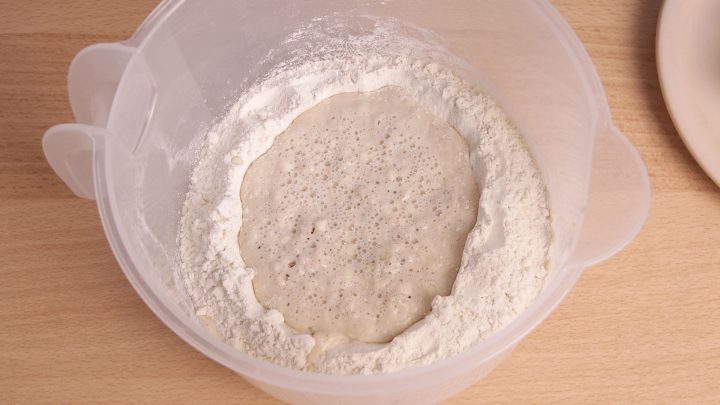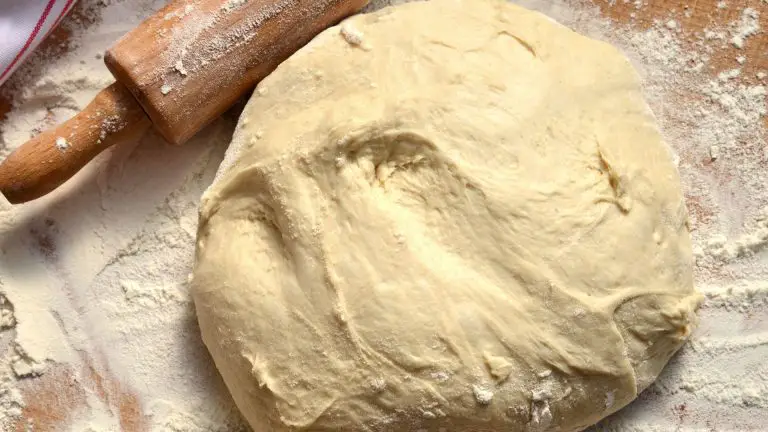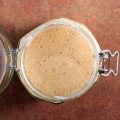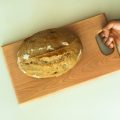In the realm of bread making, two notable contenders have emerged: Poolish and Sourdough Starter. These fermentation agents, each with their unique origins and properties, hold the key to achieving exquisite loaves with distinct flavors and textures. Delve into their characteristics to unravel their significance in the art of baking.

Table of Contents
- What is Poolish?
- What Is The Difference Between Levain and Poolish?
- Can You Substitute Sourdough Starter With Poolish?
- Sourdough Poolish Recipe
- Poolish Starter
- FAQs

Poolish Recipe
This simple yet powerful technique combines the tangy flavors of sourdough with the lightness and convenience of a poolish. Discover how to create a flavorful and airy pre-ferment that will elevate your homemade bread to new heights.
Ingredients
- 100 grams bread flour
- 100 grams water
- 25 grams mature sourdough starter (100% hydration)
Instructions
- In a clean mixing bowl, combine the bread flour, water, and mature sourdough starter. Mix well until all the ingredients are fully incorporated and form a thick, sticky batter.
- Cover the bowl with plastic wrap or a clean kitchen towel and let it sit at room temperature for 8 to 12 hours. This allows the poolish to ferment and develop flavor.
- After the fermentation period, the poolish should appear bubbly and have a slightly tangy aroma. It should also have risen and expanded in volume.
- At this point, the sourdough poolish is ready to be used in your bread recipe. You can proceed to incorporate it into your final dough according to the specific bread recipe you’re following.
What is Poolish?
The primary purpose of a Poolish is to enhance the flavor and texture of bread. It is a pre-ferment made by combining equal parts flour and water with a small amount of yeast.
By allowing the Poolish to ferment overnight or for several hours, it develops complex flavors, increases dough extensibility, and improves the overall rise of the bread. Poolish also contributes to a more open crumb structure and adds a subtle sweetness to the final product.
Bakers often utilize Poolish as a flavor-enhancing agent to create artisanal bread with depth and character.
Is Poolish The Same As Sourdough Starter?
No, Poolish is not the same as a sourdough starter.
Poolish is a type of pre-ferment used in bread making, particularly in French baking. It is made by combining equal parts of flour and water with a bit of commercial yeast. The mixture is then left to ferment for a specific period, usually overnight or up to 24 hours, before being incorporated into the final dough.
Poolish enhances flavor development, improves texture, and helps create a more open crumb structure in bread.
On the other hand, a sourdough starter is a naturally fermented mixture of flour and water. It contains wild yeast and lactobacilli bacteria naturally present in the environment. By regularly feeding the starter with fresh flour and water, the yeast and bacteria become active and multiply, creating a leavening agent that can be used to make bread without the need for commercial yeast. Sourdough starters have a distinct tangy flavor and can take several days or even weeks to develop fully.
While both Poolish and sourdough starter contribute to the fermentation and flavor development in bread, they differ in their composition and method of preparation. Poolish relies on commercial yeast for fermentation, while a sourdough starter relies on wild yeast and bacteria naturally present in the environment.
What Is The Difference Between Levain and Poolish?
Levain and Poolish are both types of pre-ferments used in bread making, but they differ in their composition and method of preparation.
Levain, also known as a sourdough starter or sourdough culture, is a naturally fermented mixture of flour and water. It contains wild yeast and lactobacilli bacteria naturally present in the environment. A levain is typically made by combining flour and water and allowing it to ferment over several days or weeks, with regular feedings of fresh flour and water. This process allows the wild yeast and bacteria to become active and multiply, creating a leavening agent that can be used to make bread without the need for commercial yeast.
Levain imparts a distinct tangy flavor to bread and requires a longer fermentation time compared to Poolish.
On the other hand, Poolish is a type of pre-ferment made with commercial yeast. It is typically prepared by combining equal parts of flour and water with a small amount of commercial yeast. The mixture is then left to ferment for a specific period, often overnight or up to 24 hours, before being incorporated into the final dough.
Poolish helps enhance flavor development, improve texture, and create a more open crumb structure in bread.
Are Poolish and Levain Both Preferments?
Yes, both Poolish and Levain are types of preferments used in bread making.
A preferment, also known as a pre-ferment or starter, is a portion of dough that is prepared in advance and allowed to ferment before being incorporated into the final dough. Preferments are used to enhance flavor development, improve texture, and increase the rise of the bread.
Poolish is a type of preferment made with commercial yeast. It is typically prepared by combining equal parts of flour and water with a small amount of commercial yeast. The mixture is then left to ferment, often overnight or up to 24 hours, before being incorporated into the final dough.
Levain, also known as a sourdough starter or sourdough culture, is a naturally fermented mixture of flour and water. It contains wild yeast and lactobacilli bacteria naturally present in the environment. A levain is typically made by combining flour and water and allowing it to ferment over several days or weeks, with regular feedings of fresh flour and water. The active levain is then used as a preferment in bread making.
Both Poolish and Levain serve as preferments that contribute to flavor development and texture improvement in bread. They provide different characteristics and flavors to the final product, allowing bakers to create a wide range of bread variations.
Is Levain or Poolish Better for Baking Bread?
Whether Levain or Poolish is better for baking bread depends on personal preference and the desired characteristics of the bread you want to achieve. Both Levain and Poolish offer distinct benefits and can contribute to the flavor, texture, and rise of the bread in different ways.
Levain, or sourdough starter, imparts a unique tangy flavor to bread due to the presence of wild yeast and lactobacilli bacteria. It also provides a longer fermentation time, which can result in more complex flavors and improved digestibility. Levain can enhance the keeping quality of bread and often produces a more open crumb structure. Additionally, sourdough bread made with levain tends to have a thicker, chewier crust.
On the other hand, Poolish, made with commercial yeast, ferments relatively quickly and contributes a more subtle flavor to bread. It helps develop a mild, slightly sweet taste and can contribute to a lighter, more airy texture. Poolish is often favored for recipes that require a shorter fermentation time or when a milder flavor profile is desired.
Can You Substitute Sourdough Starter With Poolish?
Yes, it is possible to substitute a sourdough starter with Poolish in certain bread recipes, although there will be some differences in flavor and fermentation time.
To substitute a sourdough starter with Poolish, you can follow these general guidelines:
- Calculate the amount of Poolish needed: Determine the amount of sourdough starter called for in the recipe and use an equal amount of Poolish instead. For example, if the recipe requires 200 grams of sourdough starter, make a Poolish with 100 grams of flour and 100 grams of water.
- Adjust the yeast amount: Since Poolish already contains commercial yeast, you may need to reduce the amount of additional yeast called for in the recipe. Consider reducing the yeast quantity by about 25-50% to account for the yeast already present in the Poolish.
- Adjust the fermentation time: Poolish typically ferments relatively quickly, usually overnight or up to 24 hours. In contrast, sourdough starter fermentation can take longer, often several days or even weeks. Therefore, if you substitute a sourdough starter with Poolish, you may need to adjust the fermentation time accordingly. Monitor the Poolish closely during fermentation to determine when it is ready to be incorporated into the final dough.
- Consider flavor differences: Sourdough starter contributes a distinct tangy flavor to bread, while Poolish provides a milder flavor. Keep in mind that substituting a sourdough starter with Poolish will result in a slightly different taste profile in the final bread.
Sourdough Poolish Recipe
Introducing the delightful world of sourdough poolish! This simple yet powerful technique combines the tangy flavors of sourdough with the lightness and convenience of a poolish. Discover how to create a flavorful and airy pre-ferment that will elevate your homemade bread to new heights.
Let’s get started!
Ingredients
- 100 grams bread flour
- 100 grams water
- 25 grams mature sourdough starter (100% hydration)
Instructions
- In a clean mixing bowl, combine the bread flour, water, and mature sourdough starter. Mix well until all the ingredients are fully incorporated and form a thick, sticky batter.
- Cover the bowl with plastic wrap or a clean kitchen towel and let it sit at room temperature for 8 to 12 hours. This allows the poolish to ferment and develop flavor.
- After the fermentation period, the poolish should appear bubbly and have a slightly tangy aroma. It should also have risen and expanded in volume.
- At this point, the sourdough poolish is ready to be used in your bread recipe. You can proceed to incorporate it into your final dough according to the specific bread recipe you’re following.
Poolish Starter
Understanding Poolish and sourdough starter differences is crucial. Poolish offers quick fermentation and mild flavor, while sourdough starter brings tanginess and complexity.
Choose based on preference: convenience and lightness with Poolish or depth and extended fermentation with sourdough starter. Both enhance bread flavor and texture. Experiment for delicious results.
FAQs
Why Use a Preferment in Bread Baking?
A preferment, such as a sourdough starter or a poolish, is used in bread baking to enhance flavor, improve texture, and increase shelf life. It allows for longer fermentation, which develops complex flavors and breaks down gluten for a lighter, more digestible bread.
What is Poolish vs Biga For Sourdough?
In sourdough baking, poolish and biga are both types of preferments used to enhance flavor and texture. Poolish is a wetter preferment with equal parts flour and water, while biga is a stiffer preferment with less hydration. Both contribute to a more complex and flavorful sourdough bread.




![7 Oldest Sourdough Starter In The World [Believe It Or Not!] 48 7 oldest sourdough starter in the world [believe it or not! ]](https://www.mydailysourdoughbread.com/wp-content/uploads/2023/01/blog-images-21-2-120x120.jpg)
